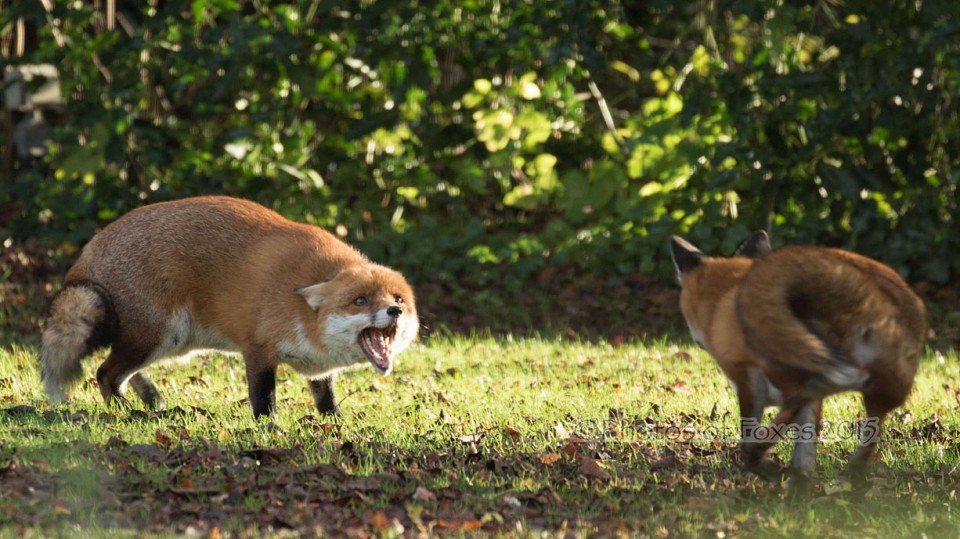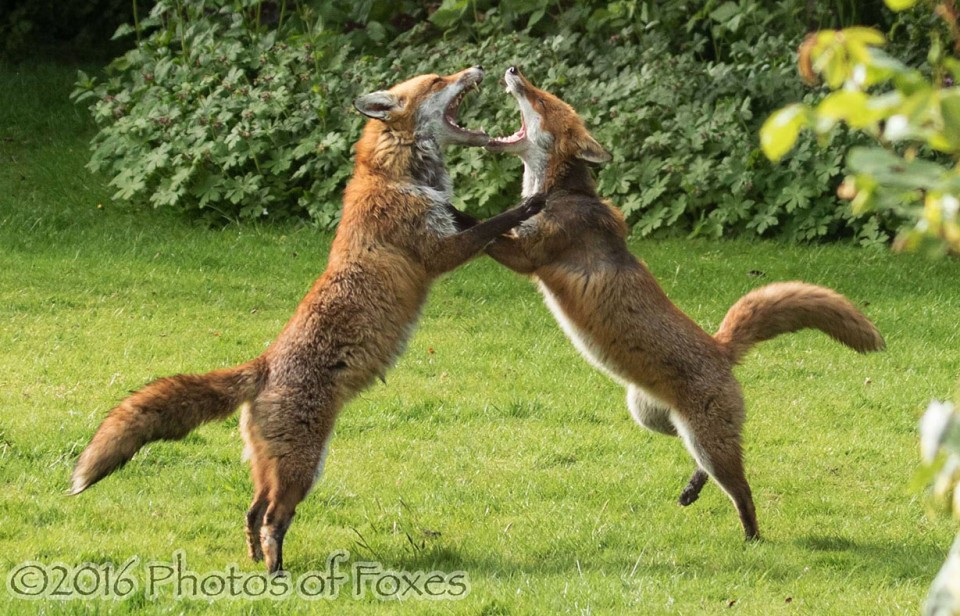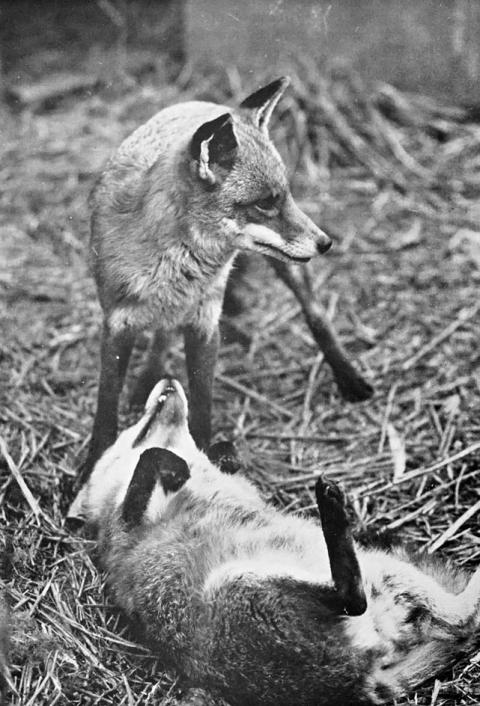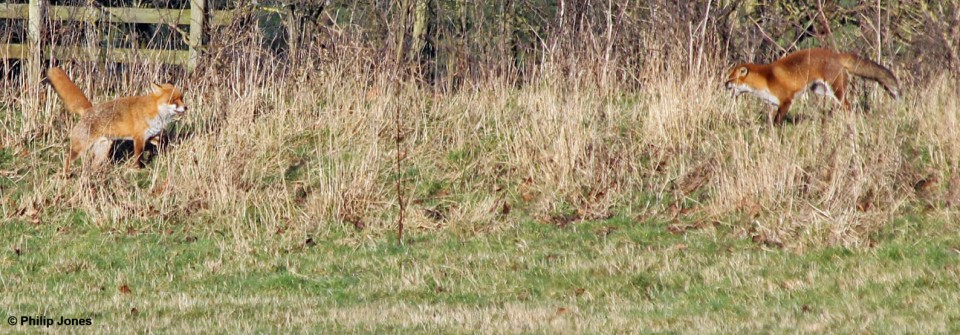Red Fox Behaviour - The Social Hierarchy
Traditionally, canid social structure had been seen as a strict hierarchy with a "top dog" (called an alpha) a second in command (a beta), possibly other "rungs" (delta, gamma, etc.) down to the lowest member in the hierarchy (the omega), who bears the brunt of the others' aggression. This is perhaps most familiar to those of us who own dogs and have, based on studies of wolf packs, been told we "have to show them who's boss".
This hierarchical model was, however, established based on observations of unrelated captive animals who, with nowhere to go (there being no chance of dispersal in captivity), were forced to fight in order to establish a place for themselves in the "pecking order" (so-called because it was first documented in chickens). Even David Mech, who conducted much of the early work, warned against applying the model to wild populations. Indeed, recent work on domestic dogs has shown that these canids aren't stupid; they don't think humans are part of their "pack" and, while it is possible for a human to enforce obedience through punishment, it is also possible (in fact, long-term, far more stable and rewarding) to establish the same level or obedience with positive reinforcement training.
In reality, most canid social groups are nuclear families, consisting of breeding pair and several offspring from previous years. There typically is a social structure within the group, but it seems to be more flexible than the early studies suggested. Despite being familial fox groups still show a distinct social hierarchy, with some individuals being openly submissive to others. The hierarchy may not be fixed but an individual's placement within it can determine their access to food; this can influence how quickly a cub grows, how much social contact an animal gets and how likely it is to disperse.

The hierarchy among the cubs develops early on and is modified throughout its life. Observations of captive foxes and infrared video of wild fox earths suggest that the foundations of a pecking order are evident in animals as young as one week old; the cubs pushing each other out of the way for access to milk. Indeed, during her studies of early fox life history during which she deployed infrared cameras inside wild fox earths, Bristol University behaviourist Sandra Alvarez-Betancourt noted that aggression was the first social interaction the cubs exhibited, from at least three weeks old, with the vixen making no attempt to break up the squabbles. David Macdonald has observed that the individual characters of the cubs are discernible as soon as their eyes open (around two weeks old); the runt (or omega), who is constantly harassed and attacked by its littermates, is also evident from this age.
It seems that, from about three weeks old, the cubs squabble over pieces of meat and the largest cub -- irrespective of sex, but typically a male -- is usually the alpha. Indeed, it seems that most animosity exists only when food is around, with cubs fighting fiercely to keep it by slamming aggressively into each other with sideways "body slams". It is not unknown for fox cubs to kill (and eat) each other during this initial period of social establishment, and it is estimated that perhaps one-in-five (20%) cubs dies underground, although how many perish as a result of fights with littermates as opposed to illness/malnutrition is unknown.
In his article on how to watch foxes, published in the BBC Wildlife Magazine during 2007, Stephen Harris noted that the social structure among the cubs has been established around the time the cubs emerge from the earth (at about six or seven weeks old) and serious fights are rare from this point. While above ground, the cubs will spend much of their time play fighting, which helps not only to reaffirm their place in the hierarchy, but also develops their hunting skills and muscle tone, which will be crucial in later life. At the same time, foxes will groom each other, which helps reinforce social bonds and appears to provide pleasure to both parties. It has been suggested that a lack of grooming may induce social isolation and make an individual more likely to disperse come the autumn (see Dispersal).

So, how does a fox group establish and maintain this hierarchy? Many readers will be familiar with the sights (perhaps more likely, the sounds) of fox fights but, while fighting does play a role in establishing and maintaining a hierarchy, it is not always required and if it is, it usually comes into play late in the encounter. Generally speaking, foxes don't want to fight with each other -- it uses a lot of energy and risks serious physical injury, even death. Consequently, foxes (indeed, canids in general) have evolved a suite of highly ritualised displays and vocalisations that help establish dominance. These displays take the form of exaggerated body posturing and facial expressions; much can also be conveyed by the position of the ear and tail and the state of the fur.
It is something of a generalisation, but a fox standing tall with an erect (or steeply upward sloping) tail, raised/bristling whiskers, and erect ears is dominant in an encounter -- if the ears are flattened to the side of the head, against the neck, and the hackles on the back of the shoulders raised the animal is ready to attack. By contrast, lying on the ground with the head lowered, ears flat against the top of the head, tail curled underneath (or tightly alongside) the body and mouth agape is the typical submissive behaviour exhibited by foxes.
Essentially, the dominant fox will walk tall, while the submissive animal will attempt to get as low to the ground as it possibly can; in the case of the vixen, the fox may even roll over, exposing the vulnerable stomach and genitals as a sign of submission. One cannot, however, base our interpretation of an encounter based solely on the body posture: the facial expressions of the foxes involved in the conflict are also highly significant.
American canid biologist and veterinarian Michael Fox is responsible for much of our understanding of how dominance-submissive behaviour operates among the canids. Fox's studies during the 1970s established that the "submissive crouch" involved the animal remaining low to the ground, with its head extended, ears flat and eyes narrowed, with the gaze directed away from the dominant animal. A dominant animal, according to Fox's studies, stares directly at the submissive animal. Both animals may gape; their mouths may be open between 10-degrees and 60-degrees. It should be noted, however, that gaping and closed eyes does not necessarily indicate an aggressive encounter (see below).
In many cases, the two foxes are members of the same social group and the submissive behaviour of one to the other is sufficient to establish dominance. There are, however, cases where there is competition for territory or mates and one fox may be attempting to overthrow the existing territory holder -- in such cases both will initially display dominant body language and a stand-off may ensue. The two foxes stand side-by-side, their backs arched, tails curled to the side, ears flat and their heads away from each other -- often both will gape. This close proximity allows each animal to assess its opponent and, in some cases, one may immediately exhibit submissive body language and crawl angled away. Assuming that neither individual backs down, they will turn their heads to face each other and "body shove" each other, testing their strength; this rapidly escalates into a fight, with each animal biting at the back of the neck and shaking. Each fox also attempts to bite the head (sometimes the rump) of the other; facial/neck injuries are common wounds found on foxes during the breeding season, when males are competing for access to females.
In some cases the foxes may rear up to face one another, with ears flat, mouth agape, hind feet widely-spaced, tails curved out and downwards, with front paws on the shoulders of the other fox (holding each other at a roughly 45-degree angle): this is the aptly-named foxtrot. Unlike the elegant ballroom dance (which apparently actually gets its name from the actor Henry Fox, who is credited with its invention in 1914), there is nothing smooth or sophisticated about two foxes engaged in a foxtrot.
Each fox attempts to push the other backwards, screaming with sharp explosive vocalisations (called "gekkering") as they go. The winner appears to be the one that successfully topples their opponent or causes their opponent to turn away. In some instances, the "battle" may be prolonged and, when no clear winner emerges, it ends with both animals lying on the ground screaming at each other. Despite how aggressive an encounter may look or sound, bloodshed and/or serious injury is rare. Indeed, that is the point of this highly ritualised displaying -- it allows the animals to establish dominance passively, without the need for violent combat (and hence serious injury). Foxtrotting is arguably more common among quarrelsome vixens, but dog foxes, particularly those reaching sexual maturity, will often engage in the behaviour with siblings, and on occasion a vixen may trot with an overzealous dog. Cubs may also foxtrot to settle disputes or as part of play.

Many studies on fox society suggest that it is the dominant pair that is primarily responsible for territory maintenance and the dog appears to do most of the scent marking and fighting with interlopers. Fights among vixens are not, however, uncommon and a dominant vixen may squabble with other subordinate vixens in her social group, or engage in fights with neighbouring vixens. In some cases, the dominant vixen and dog may work together to see off an intruder. David Macdonald recounted just such an encounter in Running with the Fox.
Macdonald described a fight between two adult vixens that was accompanied by much gekkering and screaming as the two sideways barged each other, "parried fang with fang" and rolled together in what he portrayed as a ball of fur and teeth. The resident dog fox, alerted by the commotion from several hundred metres away, came flying across the field and collided with the combatants, knocking the interloping vixen off her feet; the dog proceeded to chase the interloper out of the territory into a hedge where the fighting continued until the dog emerged, a little further down, victorious. This dog fox walked out of the hedge with a stiff-legged gait (almost prancing) holding his tail "poker-stiff and slightly above the horizontal"; classic body language of a winning fox.
Macdonald's account is an interesting one because vixens typically appear subordinate to dogs; a vixen often greet a dog with her ears flat, squirming on the ground at the dog's feet as she licks at his muzzle; she may also thrash her tail (see his photo on the right). The dog greets the vixen with his head held low, uttering a low "warbling" sound. Hence, aggression is almost invariably intrasexual (i.e., males vs. male, females vs. females), rather than intersexual (i.e., males vs. females). Indeed, Macdonald goes on to describe a "fight" between a dog and vixen from different territories at the boundary between the two groups in Israel's Judean Desert. In this case the dog pirouetted on his hind legs, holding his paws close to his chest and stepping in circles around the vixen who was squirming on the ground in typically submissive style. The dog never followed through with his attack and the vixen never retaliated.

Macdonald considered that the fact her adversary was male prevented the vixen from defending herself, while the dog was inhibited from attacking his opponent because she was female. Indeed, he observed dogs to be very tolerant of neighbouring vixens, too. Despite the occasional attack by a dog on a vixen, Macdonald never observed a vixen attack a dog and footage on the BBC's Autumnwatch series of the foxes living on the Pitsea landfill site in Essex showed a new dog fox arriving on the territory who, despite being aggressive to the male cub from that year's litter and being large, behaved submissively towards the dominant vixen.
In fox society, the dominant pair tends to share the same hierarchical status (the dog is often dominant over the vixen, although there may come a point where the vixen has been as tolerant as she can and rebels) and the fortunes of a subordinate can change depending on the presence of other group members. Related vixens may start out being friendly towards each other (sleeping, playing and feeding together) and, while this may continue for a long period, it can degenerate quickly with one becoming dominant over the other. When two vixens meet there are often (sometimes subtle) behavioural indications that one is dominant to the other; at the extreme a subordinate will greet a dominant vixen in the same way a vixen greets a dog, much frantic tail thrashing.
Macdonald found that, in two of his captive vixen sisters, one was completely dominant over the other and rebuked the other if she was caught taking food or getting too close to the dog fox, with which she was apparently besotted. When the dominant vixen was removed, the subordinate returned to her previously calm demeanour; it seems that a few hours respite from social oppression is sufficient to restore behaviour, suggesting the traits of social status are only skin deep. When the dominant vixen was reintroduced to the group, the subordinate's confidence collapsed again. He also observed changes in hierarchy when the dominant dog was replaced. The introduction of a new dog to his study group following the death of the previous one from leptospirosis resulted in the vixen at the bottom of the social ladder suddenly moving to the top, becoming dominant over the two that had previously been highly aggressive towards her.
In another example, Macdonald observed that a low-ranking subordinate rose instantly to the top of the pecking order when a new dog was introduced to the group following the death of the old one. A similar change in ranking was observed by Thelma Clarke among the foxes visiting her cottage in the New Forest, Hampshire. In her book, A New Forest Fox Family, Clarke described how an un-related interloping vixen went from timid lurker in the bushes to confident dominant vixen shortly after the resident dominant vixen disappeared.
Perhaps most intriguing of all is that a vixen's status in one group may affect her treatment by members of neighbouring groups. Macdonald found that, in his Israeli study group, the dominant vixen in one group also appeared dominant to low subordinates in a neighbouring group, while she was subordinate to the two top vixens in the group. Presumably there is something in the demeanour of a fox that others recognise and use to decide whether they should be challenged, although the MRU biologists observed that dominant vixens frequently mated with subordinate males from neighbouring groups (but never subordinates within their own group), suggesting that they found it difficult to assess the status of their suitor outside of the group context. Perhaps it is easier to identify a subordinate vixen than a subordinate dog away from their group?

The above illustrates how fox society and hierarchies aren't always as straightforward or simple to pigeonhole as we might hope. Some foxes are strictly territorial and will attack another individual as soon as they step across the boundary into their range. Others only fight when an intruder breaches their core area or is spotted stealing food. In fox society, coalitions may be formed to expel an intruding fox and there are even apparent reprisal attacks for the crime of stealing food. Indeed, food is pivotal in fox society and the cause of many altercations; from their first weeks of life cubs will fight ferociously to gain and keep hold of a meal. As Macdonald puts it:
"If there is one thing in fox society that is 'not done' it is to approach somebody who is eating ... foxes generally do everything possible to avoid even being seen with food and, if the worst comes to the worst, will at least turn their backs to each other while eating."
Perhaps just as important as knowing what the 'rule of engagement' are in fox society, is knowing how to make up for having broken them. Mike Towler described to me how he has observed foxes apologising to each other (and him) for having broken these rules. Towler explained:
"They have a system of apologising. Facing the other party, the fox lies down on its stomach in a straight line, forelegs like a pair of tramlines with the chin resting on them, and whimpers -- which I suspect to be a language. It is humility personified. I had witnessed it between foxes, then I was subject to it. Why? The fox had failed to recognise me, and fled. I called after her and when I caught up with her received this abject apology. Apology accepted, we went for a stroll together."

As autumn progresses, family cohesion begins to degrade and tensions rise, leading to more altercations within the group. It is often during this time that cubs will begin to leave in search of new territory and, from September onwards, the male cubs begin to mature sexually, increasing competition with their father, who will become increasingly intolerant of them. In some cases, subordinates may launch a coup and oust the dominant animal(s), although this appears rare. There is also some suggestion that, if the dominant vixen becomes barren (through old age), she may fall in the ranks and become subordinate to one of her daughters.
Finally, some authors have observed two hierarchical restructures in a year. During his study on foxes in Alaska, Cornell University biologist Robert Vincent recorded a reshuffle in November just before the breeding season, which was often violent, and a second during February, during which less fighting occurred. Vincent noted that much of the hierarchy remained the same, except for the addition of dominant animals and the departure of the lowest members. The place an individual holds in the hierarchy following any reshuffling is important because it affects their breeding performance: as we have seen (see Breeding Biology), it is typically (though not exclusively) only the dominant animals in the group that breed.